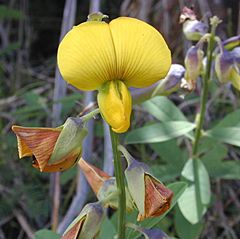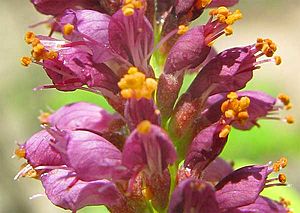Faboideae facts for kids
Quick facts for kids Faboideae |
|
|---|---|
 |
|
| Crotalaria retusa | |
| Scientific classification | |
| Kingdom: | |
| Division: | |
| Class: | |
| Order: | |
| Family: | |
| Subfamily: |
Faboideae
|
The Faboideae are a very large group of flowering plants. They are a major subfamily within the Fabaceae family, also known as the Leguminosae. You might also hear them called Papilionoideae. Sometimes, when this group is seen as its own family, it's called Papilionaceae.

These plants grow all over the world. They can be found in many different places, from hot deserts to cool forests. Faboideae plants come in many forms. Some are tall trees, others are bushy shrubs, and many are smaller herbs.
One special thing about most Faboideae plants is their unique flowers. They often look like butterflies, which is why they are called "papilionaceous" (from the Latin word for butterfly). Another amazing feature is their ability to form root nodules. These are small bumps on their roots that help them take nitrogen from the air and turn it into food. This process is called nitrogen fixation.
Many plants you know are part of the Faboideae subfamily. For example, vetch, Laburnum, and Sweet pea are all members of this diverse group.
Contents
What Are Faboideae Plants?
The Faboideae are the largest group within the pea family. They include a huge variety of plants, from tiny wildflowers to large trees. These plants are important for many reasons. They provide food for humans and animals. They also help to make the soil healthier.
Where Do Faboideae Grow?
Faboideae plants are found almost everywhere on Earth. They grow in forests, grasslands, deserts, and even mountains. This shows how well they can adapt to different climates and environments. Some Faboideae plants like warm, sunny places. Others can survive in colder areas. Their ability to grow in many places makes them very successful.
Special Features of Faboideae
Faboideae plants have several unique features that help them survive and thrive.
Butterfly-like Flowers
Most Faboideae plants have flowers that look like butterflies. These flowers usually have five petals. One large petal is at the top, like a "standard." Two petals are on the sides, like "wings." The last two petals are joined together at the bottom, forming a "keel." This shape helps pollinators, like bees, reach the nectar inside.
Root Nodules and Nitrogen Fixation
One of the most important features of Faboideae plants is their special relationship with tiny living things called bacteria. These bacteria live in small bumps on the plant's roots, called root nodules. The bacteria take nitrogen gas from the air and change it into a form that the plant can use as food. This process is called nitrogen fixation. It's like the plant has its own natural fertilizer factory! This also makes the soil richer in nitrogen, which helps other plants grow too.
Diverse Plant Forms
Faboideae plants can be many different shapes and sizes. Some are tall trees, like the black locust. Others are shrubs, like broom. Many are smaller herbs, like clover or alfalfa. This variety allows them to fill many different roles in their ecosystems.
Importance of Faboideae Plants
Faboideae plants are very important to both nature and humans.
Food and Agriculture
Many Faboideae plants are grown for food. Think about peas, beans, lentils, and peanuts. These are all part of this subfamily. They are packed with protein and are a vital food source around the world. Other Faboideae plants, like clover and alfalfa, are grown to feed farm animals.
Soil Health
Because of their nitrogen-fixing ability, Faboideae plants are great for improving soil quality. Farmers often plant them to add natural nitrogen to the soil. This reduces the need for chemical fertilizers. It also helps other crops grow better. This practice is called crop rotation.
Other Uses
Beyond food and soil improvement, Faboideae plants have other uses. Some are grown for their beautiful flowers in gardens. Others provide wood or materials for making dyes. For example, indigo dye comes from a plant in this family.
See also
In Spanish: Faboideae para niños


